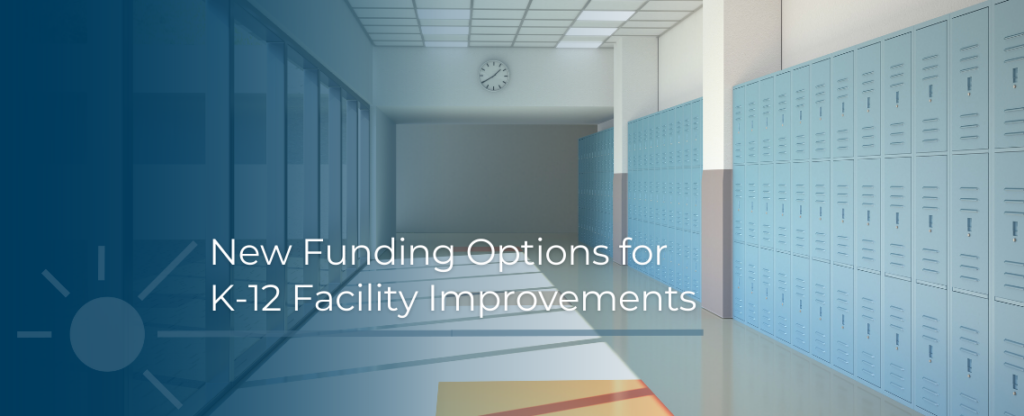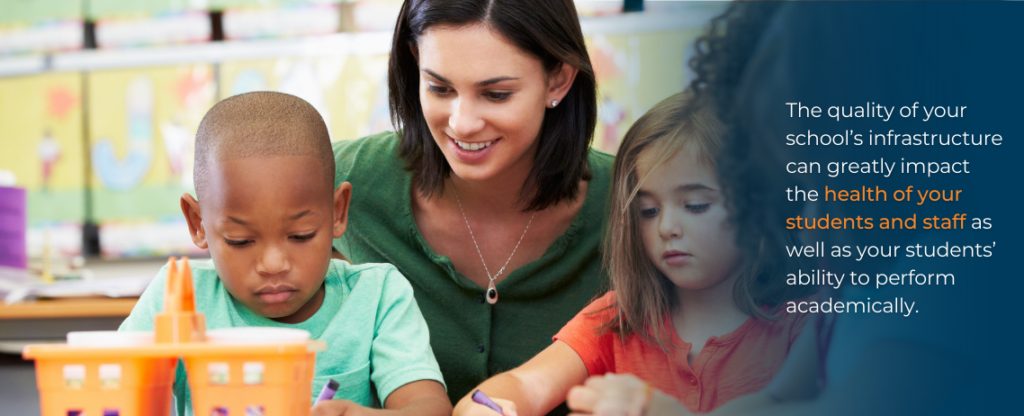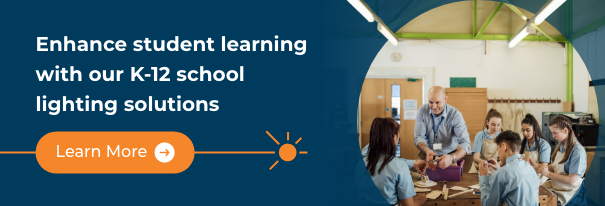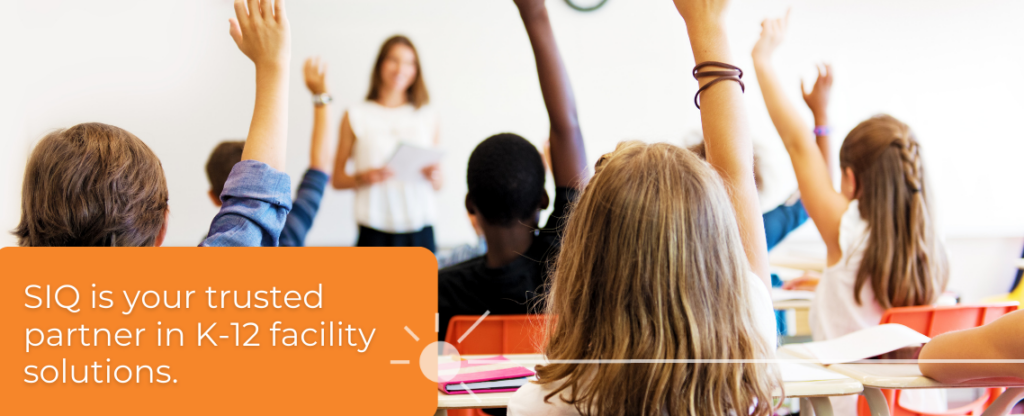
Each year, schools across the country are home to new students and staff, each with unique and varying educational programming needs . As a space for both education and personal growth, your school’s learning environment may require upgrades to improve comfort, safety, and indoor air quality, which impact students’ health and performance. Funding for these types of infrastructure projects is often limited, however, both the Infrastructure Investment and Jobs Act and the Inflation Reduction Act may be the key to helping you implement necessary facility improvements and meet district goals.
Infrastructure Investment and Jobs Act
The Infrastructure Investment and Jobs Act (IIJA) also known as the Bipartisan Infrastructure Law (BIL) was signed into law by President Joe Biden in November 2021. The investment into rebuilding America’s infrastructure includes a variety of funding opportunities to improve schools facilities by delivering health and safety upgrades. The Department of Energy recently announced a funding opportunity under its Renew America’s Schools grant program to fund projects involving:
- High-Impact Energy Efficiency and Health Improvements, which includes direct reductions to school’s energy costs, increase in energy efficiency, and improved teacher, and student health benefits
- Innovative Energy Technology Packages, which includes energy efficiency measures, renewable energy technologies, and alternative fuels for school uses
Eligible applicants should look for an additional round of funding applications to be announced Spring 2024.
Inflation Reduction Act
The Inflation Reduction Act (IRA) was signed into law by President Joe Biden in August 2022. This Act prioritizes the investment into renewable energy and related technologies, such as the deployment of heat-pumps, community solar, and EV charging stations. The IRA will offer funding for projects involving:
- Energy efficient equipment and installation (HVAC, lighting, etc.)
- Renewable energy systems
- Demand control energy storage
- Water conservation fixtures
- EV charging fleets and infrastructure
In addition, dedicated funding sources for school air quality grants and technical assistance has been created as a part of the IRA in partnership with the Environmental Protection Agency (EPA). These specific grants include:
- $37.5M for activities to monitor and reduce air pollution and greenhouse gas emissions at schools in low-income and disadvantaged communities, and
- $12.5M for technical assistance to schools in low-income and disadvantaged communities to address environmental issues; develop school environmental quality plans that include standards for school building, design, construction, and renovation; and to identify and mitigate ongoing air pollution hazards.
Also falling under the IRA, the Affordable Clean Energy Plan will allow K-12 districts to tap into clean energy tax incentives through new direct pay opportunities, as well as other new or expanded grant and loan programs. The tax incentives will help enable school districts to implement renewable energy, including solar and geothermal. These specific incentives include:
- A tax deduction of up to $5 per square foot for energy efficiency upgrades, such as installing air source heat pumps, LED lighting, and heat pump water heaters.
- A tax credit up to $33 per MWh under the Production Tax Credit (PTC), a tax credit for clean energy production like solar energy.
- Clean Energy Investment Tax Credit (ITC) of 30%-70% of installation costs for renewable energy products.
The Treasury Department is developing additional guidance around how the tax incentives will be treated for non-tax bearing entities. Guidance regarding the direct pay applications for these types of eligible applicants should be released before the end of the year.
The Internal Revenue Service (IRS) is planning to release an application to pre-file this fall. Eligible applicants can file for tax credits on systems and solutions – such as solar energy, LED lighting, etc. – that have already been implemented in 2023.
How These Projects Benefit Your K-12 District

As mentioned in our How K-12 Facilities Impact Student Learning and Health blog, the quality of your school’s infrastructure can greatly impact the health of your students and staff as well as your students’ ability to perform academically. We know that your top priority is keeping them in the learning environment. The IRA program can provide funding to help your district complete facility updates to create a healthier learning environment while improving your energy efficiency. Some examples of improvement projects the funding may support include:
1. Lighting
While natural light has a variety of positive influences on learning and productivity due to its psychological and physiological effects, it’s not without its disadvantages. It can’t be the only light source, of course, as inclement weather, early winter darkness, and nighttime events all require a secondary source of lighting.
Energy-saving lighting is an area where many schools can save money. Replacing old, headache-inducing lights with LED bulbs can reduce energy costs, decrease maintenance needs, and even improve safety due to their reduced heat output. These eco-friendly lights can also pair with advanced lighting controls.
Connecting your lights to the Internet of Things (IoT) can automate the task of keeping your building bright. You can reduce consumption by turning off lights in spaces that are not in use or install lights that respond to the amount of natural daylight present, reducing or increasing the brightness as necessary. Many of these commercial lighting retrofit solutions can also help make your facility more sustainable.

2. Indoor Air Quality
Indoor air quality (IAQ) has a pronounced effect on children compared to adults, making IAQ in schools a matter of special importance. Poor IAQ can have an immediate impact on students and teachers, causing allergic reactions or asthma attacks in severe cases. IAQ impacts comfort levels as well, either promoting or detracting from positive attitudes and concentration. No one wants to feel trapped in a stuffy room.
In addition to these immediately felt consequences, exposure to pollutants like dust, mold, and mildew can be detrimental to health long-term. One study even found that teachers with prolonged exposure to relative humidity levels that were either too high or too low were more likely to experience respiratory problems. Bacteria, viruses, allergens, and irritants may continue to thrive in a room despite efforts to sanitize surfaces because the RH is contributing to the problem.
Every school should have their IAQ assessed to determine effective improvement measures. This includes auditing the HVAC system and identifying any potential pollutants that need to be filtered. A humidifier or dehumidifier may help maintain comfortable and healthy RH levels.
3. Solar Energy
For most school districts, energy costs are one of the highest budget expenditures. Often, school leadership is unaware that solar power can allow them to make a significant reduction in their energy consumption.
With solar panel installation, schools can meet the growing need for a sustainability program and save money that can be shifted for other district needs. Solar energy generation can help K-12 districts saves thousands in utility bills, create an eco-friendly and sustainable environment for its community, future-proof with a long-term solution for reliable energy sources, and provide an opportunity to educate its students about renewable energy and how to practice energy efficient habits with real examples.
Your Next Step to a Healthier K-12 Space
Now is the time to identify and plan for facility upgrades and improvements, and partner with a facility solutions expert to help deliver those projects. These unique funding opportunities will be competitive and have a limited application window.
At SitelogIQ, we understand that your district is unique. We work closely with you through the funding application process and develop a customized plan for how to improve your school’s facilities and learning spaces for your students and staff.

If you need help developing an effective solution to boost the health and learning of your staff and students, SitelogIQ is an industry leader in K-12 facility management solutions. Contact us today to learn more about our solutions and how we can help you create a healthy and save learning environment.




